
Updated on: September 20, 2024
Instagram comes with several risks for young users, including exposure to inappropriate content, the possibility of cyberbullying, and the increased likelihood of encountering predatory strangers online. Due to this, it’s crucial you stay informed about your children’s activities on Instagram.
Luckily, you can keep your kids safe on Instagram with a good parental control app, especially if you want to keep an eye on your kid’s chats on Instagram, which its built-in parental controls don’t do. These apps also set better screen time limits and have great filters for inappropriate content.
My favorite parental control app to keep your kids safe on Instagram is Bark. It has advanced AI technology that scans your child’s Instagram messages for risks, such as online predators, cyberbullying, and inappropriate content. Whenever Bark finds an issue, it sends you an alert with a snippet of the message. I like this way of monitoring, as it allows me to keep my kids safe online without being too intrusive.
However, aside from using a parental control app, there are several other safety tips you can follow. Today, I’m going to teach you the risks of Instagram, the steps you can take to avoid those risks, and how you can talk to your kids about staying safe online.
What Are the Risks of Using Instagram?
Using Instagram comes with several risks — from security vulnerabilities and oversharing personal information to online predators and cyberbullying. Understanding the risks on Instagram allows you to take steps to ensure a safer Instagram experience for your kids.
Security Risks
Instagram is not immune to security risks. Among the various security risks your kids can face on the platform, two of the most common ones are hacking and malware:
- Hacking. Instagram accounts are prime targets for hackers. Unauthorized access to your kid’s Instagram can lead to data breaches and misuse. Once hacked, your kid’s personal information and images can be exploited or shared without their consent.
- Malware. Malicious software can find its way onto Instagram through links or downloads. When your child clicks on suspicious links or interacts with infected content, it can lead to malware infecting and even disabling their device. These malware types can range from data-stealing trojans to ransomware.
Privacy Risks
Kids don’t often think about the risks of oversharing their personal information on Instagram. There are several privacy risks on Instagram, such as:
- Data collection. Instagram collects your kid’s data, including their username, password, phone number, location, device information, and interactions. This is used for targeted advertising and analytics.
- Profile visibility. If not set to private, your kid’s profile is accessible to anyone, potentially allowing strangers to view personal posts and information.
- Geo-location tagging. Posting location tags can reveal where your teen spends most of their time, compromising their privacy and making them susceptible to stalking.
- Third-party apps. Linking Instagram to third-party apps (such as apps to make collages or edit pictures) may expose personal data.
You should be aware of the data your kids provide on Instagram and the potential ways in which that data may be shared.
Mental Health Risks
Although Instagram is a platform for creativity and connection, it can also trigger mental health issues, especially for younger users:
- Comparison anxiety. Constant exposure to idealized images of people and lifestyles can trigger feelings of inadequacy, low self-esteem, and even depression.
- Validation-seeking behavior. The pursuit of likes, comments, and followers can lead to a constant need for validation and approval and lead to anxiety and depression if it’s not received.
- Cyberbullying. Negative comments and cyberbullying on posts can cause emotional distress and harm the mental wellbeing of your kids.
- Addiction. The endless scrolling, likes, and notifications can become addictive, leading to excessive screen time, decreased focus on schoolwork, and neglect of real-world relationships. To help your kids maintain a healthy balance, it’s crucial to set limits on their daily screen time. A third-party app like Qustodio allows you to set time limits on the Instagram app specifically.
- Isolation. Excessive screen time on Instagram may lead to reduced real-world social interactions, which can contribute to social isolation and loneliness.
- Sleep disturbances. Excessive use, especially before bedtime, can disrupt sleep patterns, impacting overall mental health and wellbeing.
Online Predators
Online predators pose a significant risk on Instagram, particularly for minors. This is due to several factors:
- Anonymity. Instagram allows users to create accounts using pseudonyms, making it easy for predators to conceal their true identities and intentions.
- Visual appeal. Instagram’s focus on photos and videos can attract younger users who may be more vulnerable to manipulation.
- Direct messaging. The platform’s direct messaging feature provides a private channel for predators to start a conversation.
- Wide user base. Instagram has a diverse user base, including minors who may not fully understand the risks associated with online interactions (the minimum age for Instagram is 13).
Scam Risks
It’s important to know about the different kinds of scams on Instagram. Educating your kids about these scams will make it easier for your kids to recognize them:
- Romance scams. Scammers create fake profiles and act as if they’re romantically interested in your teen. This way, they can manipulate their emotions and extract money or personal details from them.
- Fake accounts. Scammers can deceive your kids into engaging in activities such as sharing personal information or tapping on links leading to fraudulent offers. They often do this by impersonating famous celebrities or brands.
- Unofficial stores. There are numerous fake shops on Instagram that sell counterfeit or nonexistent products.
- Phishing links. Your kids can be directed to malicious websites through convincing links, risking the theft of data such as passwords and credit card information.
- Giveaway scams. Scammers might create fake celebrity or influencer profiles to announce scam giveaways. They’ll ask your kids to send money to enter, but the actual giveaway doesn’t exist.
Harmful Content
Forms of harmful content on Instagram include:
- Explicit material. Inappropriate images or videos from suggested posts may appear in your kid’s feed without them following these accounts.
- Violence and hate speech. Your kids may encounter content promoting violence, hate speech, or extremist ideologies.
- Self-harm and eating disorders. Some Instagram users may post or encourage harmful behaviors related to self-harm, eating disorders, or mental health.
- Bullying and harassment. Cyberbullying or harassment in comments or direct messages can cause emotional distress and anxiety.
- Fake news and misinformation. Misleading information or fake news can spread quickly on Instagram, negatively impacting your kid’s perception of the world.
How to Stay Safe on Instagram in 2024
1. Use Parental Controls to Protect Kids & Teens on Instagram
Parental control apps allow you to safeguard your children on Instagram. Here’s how these apps can help:
- Social media monitoring. Receive alerts whenever your child encounters or shares messages or images on Instagram that might be inappropriate or concerning.
- Screen time management. Set daily screen time limits for your child’s device and/or the Instagram app, ensuring your child doesn’t spend excessive hours on the platform.
- Activity reports. Receive detailed activity reports that provide insights into your child’s Instagram usage, including time spent on the app.
- Web/app filtering. Block the Instagram app and website entirely if you need to. I used Qustodio to block the Instagram app and URL on my kid’s devices.
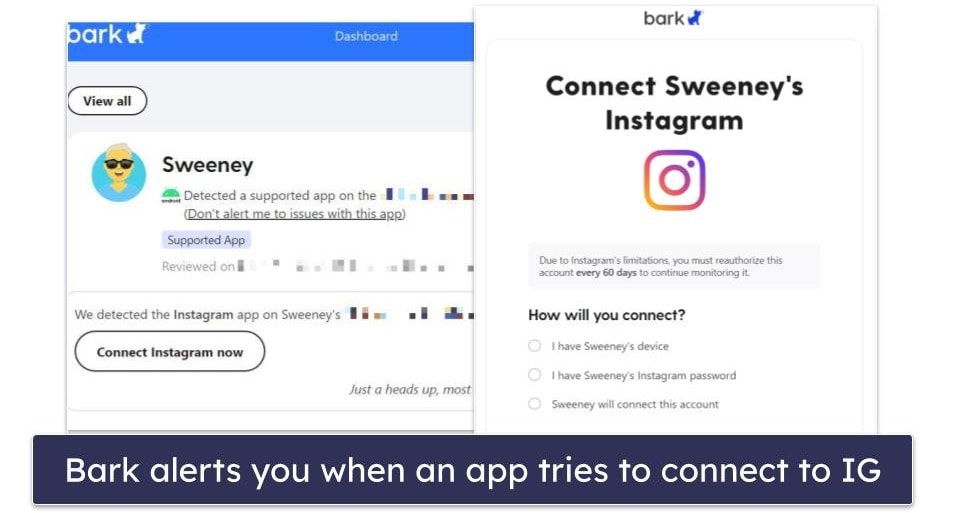
I recommend using Bark to keep your kids safe on Instagram. It offers monitoring for 30+ apps and social media platforms, including Instagram. Bark uses AI technology to scan your child’s Instagram messages for potential issues, such as cyberbullying, explicit content, and inappropriate interactions. If it detects any concerns, it sends you an alert, allowing you to take action. Plus, I like how Bark enables you to customize sensitivity levels for different issues, ensuring that you receive alerts tailored to your child’s age and maturity level.
On both Android and iOS, Bark can monitor Instagram posts, including images, videos, and captions. On Android devices, it can also monitor direct messages.
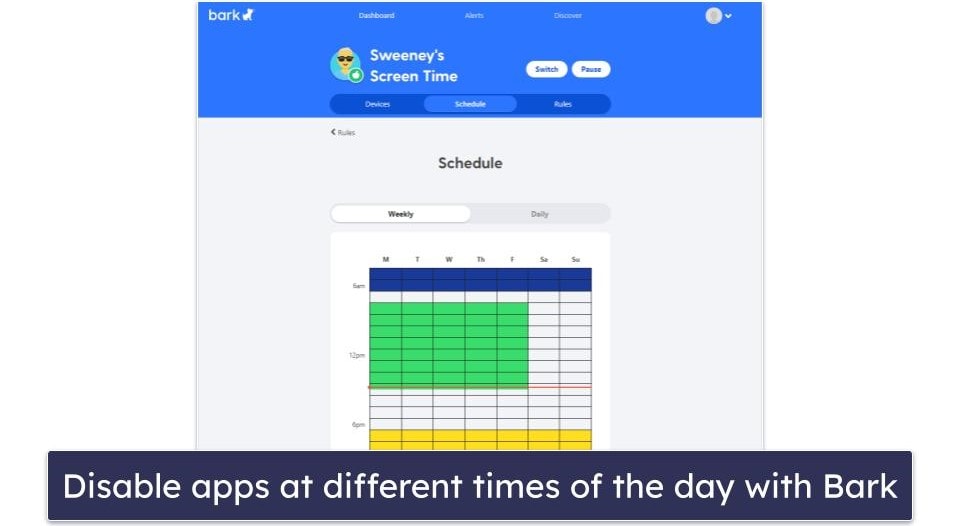
Bark also allows you to block the Instagram app and website. This way, you can be sure that your child can’t access the platform if you don’t want them to. I also like that you can set different rules for different times of the day. For example, you can allow Instagram in the evening but block it during school hours.
Unlike Qustodio, Bark doesn’t allow you to set individual time limits for the Instagram app. This means that you can only set time limits for the whole device (unless your kid is using a Bark phone).
Bark offers two plans: Bark Jr. and Bark Premium. If you want to monitor your child’s Instagram account, you’ll have to get the Bark Premium subscription ($14.00 / month). There’s a 7-day free trial, so you can test the service completely risk-free.
2. Adjust Privacy Settings
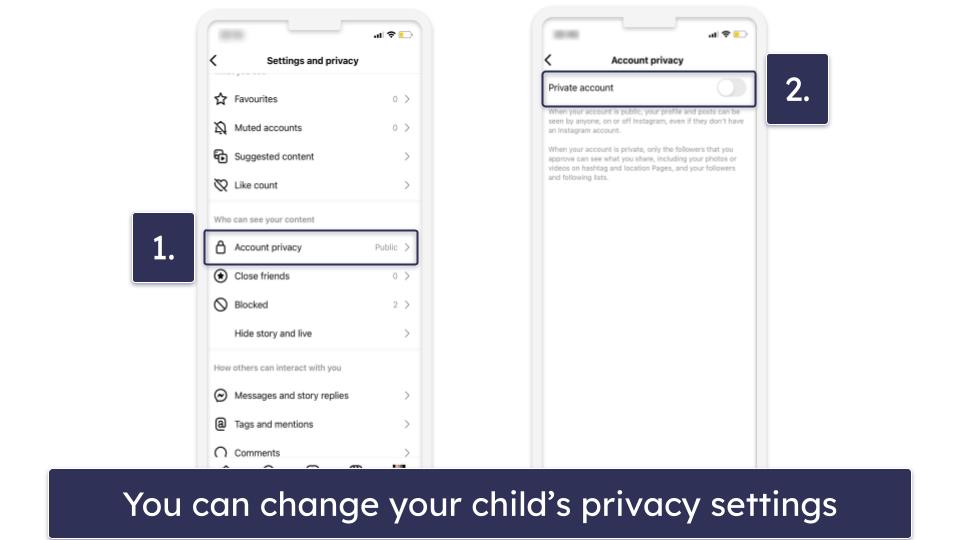
You can set your teen’s Instagram account to private, which will help ensure their safety. The private setting means anyone who doesn’t follow them can’t view their content or message them, reducing the chances of unwanted contact from strangers. Plus, if someone wants to follow your child’s account, they’ll have to send a follow request.
Instagram also allows you to turn account suggestions off. This means that when your kid follows someone’s profile, they won’t receive suggestions of similar profiles to follow, including mutual friends or acquaintances. Additionally, you can disable the activity status feature that allows people your child follows to see when they were last active on the platform. You can also prevent other users from tagging your child on Instagram posts and mentioning them in comments.
You can also disable location sharing — but keep in mind that you’ll have to disable this feature in your child’s phone settings, not in the Instagram app itself. If you do this, other users won’t know where your child is located. Be sure to educate your child about not sharing their location in their stories and posts, too.
It’s possible to block someone on Instagram completely. You can choose to block their account and any future accounts they create. After blocking, their likes and comments on your child’s posts are removed, and they can’t mention or tag your child in posts. Private messages remain in their inbox, but the blocked person can’t message your kid anymore. You can also choose alternative actions like removing them as a follower or blocking them from commenting.
NOTE: A lot of these privacy features are automatically turned on and off for Teen accounts, which are existing accounts in Instagram belonging to users that are under 18. While teens in certain countries are required to prove their age to create an Instagram account, this isn’t true for most parts of the world, so I recommend double-checking your kid’s Instagram’s privacy settings just in case.
3. Report Harassment and Bullying
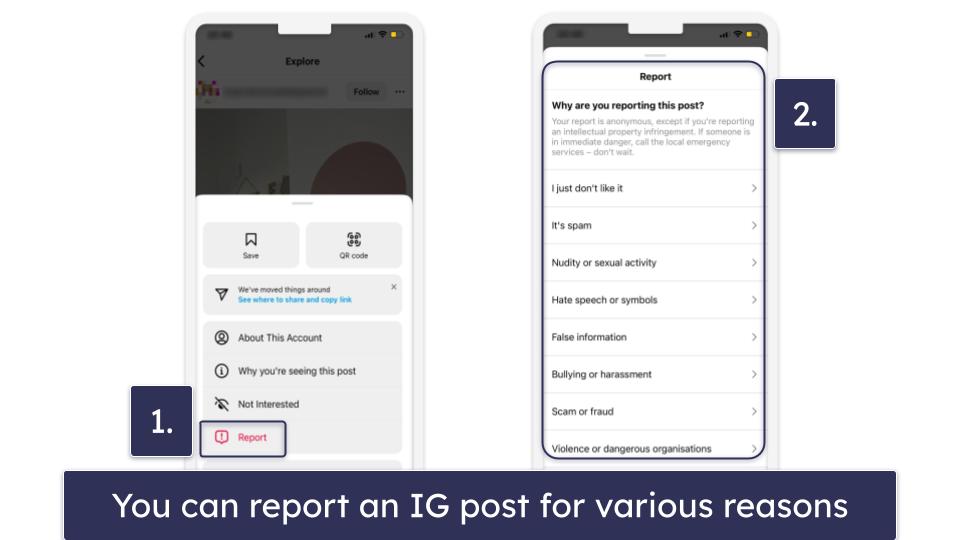
Reporting incidents of harassment or bullying helps Instagram take appropriate action, including issuing warnings, removing content, and suspending accounts. Follow the steps below to report any harassment or bullying on Instagram:
- Locate the offensive content. Find the specific post, comment, or message that constitutes harassment or bullying. It’s important to report the exact content that violates Instagram’s community guidelines.
- Report the content. Tap on the three-dot icon located next to the offending content. From the options that appear, select Report. Instagram offers different reporting categories, including harassment and bullying.
- Provide details. Instagram will prompt you to provide additional details about why you’re reporting the content. Be specific and clear in explaining how it violates the platform’s guidelines.
- Submit the report. After completing the report, tap Submit. Instagram will review the report, and your identity will remain confidential.
- Block the user. In addition to reporting, you can also block the user responsible for the harassment. This prevents them from interacting with your child on Instagram.
4. Identify Fake or Unverified Instagram Stores
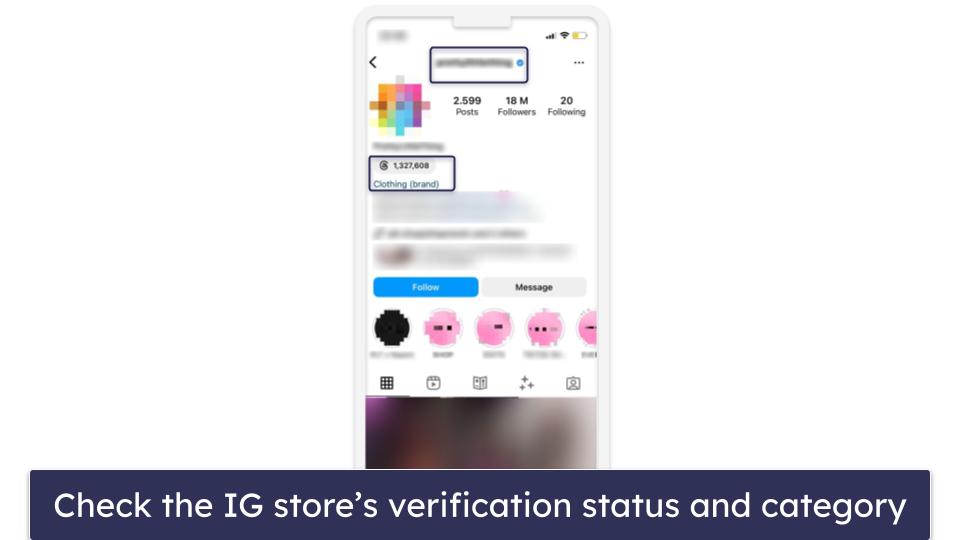
Identifying fake or unverified Instagram stores is a crucial way to avoid scams on Instagram. Here are key tips to help you identify legitimate Instagram stores and stay away from fake ones:
- Check for verification. Authentic stores usually have a blue verification badge next to their name. Verify this badge by tapping on it to see if it leads to Instagram’s official account. Although Instagram now allows anyone to get a verification badge by paying for it, it only does so for individual profiles, not for business profiles. You can tap on the category below the profile name to see if it’s a business account.
- Examine the username. Be wary of usernames that include extra characters, random numbers, or misspellings of well-known brands. Legitimate businesses tend to have clean and concise usernames.
- Review the bio. Genuine stores have detailed bios with contact information, links to their official website, and a clear description of their products or services. A lack of these details is a red flag.
- Analyze content. Look for consistent, high-quality posts showcasing the business’s products or services. Be cautious if the content appears copied or lacks originality.
- Read the comments. Read customer comments and reviews. Authentic stores have mostly positive interactions with customers, while fake ones may have few or no comments or complaints about not receiving merchandise.
- Research outside Instagram. Search for the store’s website and reviews on external platforms. Legitimate businesses should have an online presence beyond Instagram.
- Check for payment security. Before making a purchase, ensure that the store’s payment methods are secure and legitimate.
- Report suspicious accounts. If you suspect an account is fake or unverified, report it to Instagram for investigation.
5. Follow General Safety Practices
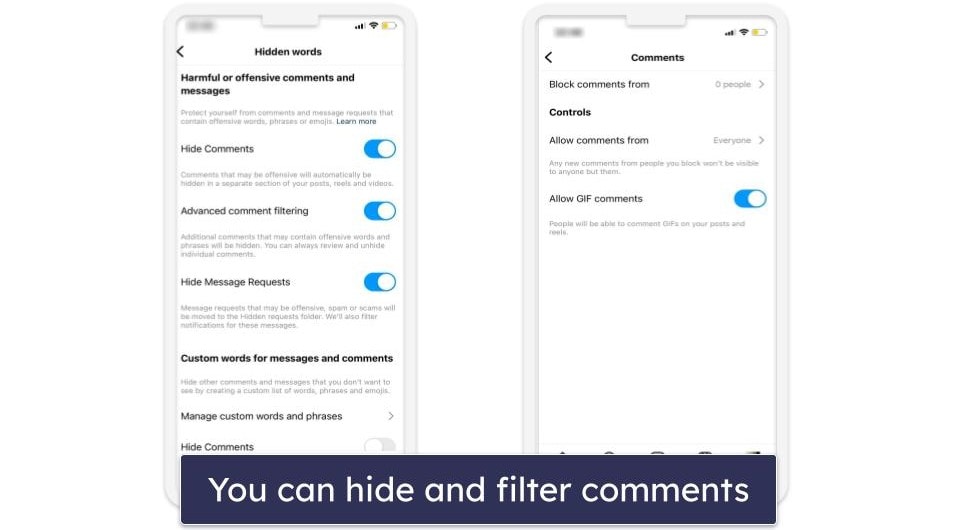
Ensuring general safety on Instagram allows you to protect your children while they use the platform. Discuss these tips for staying safe with your teen:
- Limit personal information and location. Avoid oversharing personal information, such as home addresses and phone numbers, and be cautious about sharing location details. Limiting the information your child discloses helps protect their privacy.
- Deal swiftly with negativity. Do not engage with negative comments or trolls. Instead, use Instagram’s blocking and reporting features to maintain a positive online experience. Blocking or reporting users who harass or bully prevents further interaction.
- Filter out inappropriate content. Instagram also allows you to hide or delete comments, preventing the display of offensive or inappropriate language on your child’s posts. You can create a custom list of words, phrases, and even numbers or emojis that you wish to hide in the comments on your child’s account. You can also switch on Advanced Comment Filtering, which filters out even more comments containing offensive language.
- Regularly review followers. Frequently check your kid’s followers to identify any unwanted or suspicious accounts, and encourage your teen to do the same. Blocking such accounts helps maintain a safer online environment and ensures that your child’s interactions are with trusted individuals.
6. Implement Strong Passwords and 2FA
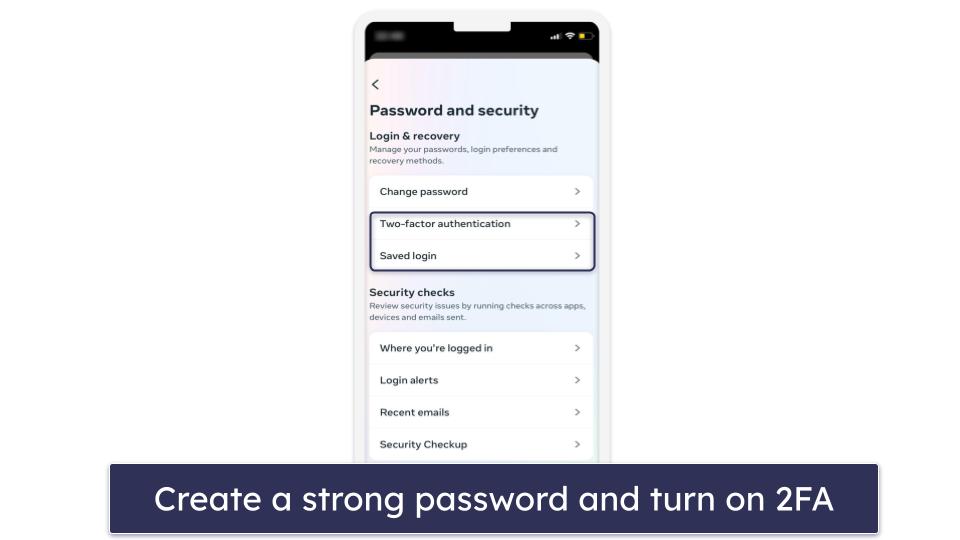
Ensuring your child’s safety on Instagram involves more than just monitoring their activity; it also means safeguarding their account from potential threats. Two essential steps are creating a strong password and enabling two-factor authentication (2FA):
- Strong passwords. Encourage your child to use a strong, unique password for their Instagram account. A good password should be long and include a combination of letters (both upper and lower case), numbers, and special characters. Avoid using easily discoverable information like birthdays or names. You can easily generate and store strong passwords by using a reliable password manager like 1Password.
- Two-factor authentication (2FA). Enable 2FA for your child’s Instagram account. This adds an extra layer of security by requiring them to enter a one-time code sent to their registered mobile number or email address whenever they log in from an unfamiliar device or location. It significantly reduces the risk of unauthorized access, even if someone somehow obtains their password.
It’s harder for hackers to get access to your child’s account if you use strong passwords and 2FA. This helps ensure your kids have a safer and more secure Instagram experience.
7. Use a VPN and an Antivirus App
Another way to keep your child safe on Instagram is by using a VPN and reliable antivirus software:
- VPN (virtual private network). Install a reputable VPN on your child’s device and encourage them to use it when accessing Instagram from public Wi-Fi networks or untrusted locations. A VPN encrypts your internet connection, making it much more difficult for cybercriminals to intercept data. Additionally, it can hide your IP address, providing an extra layer of anonymity. I recommend installing ExpressVPN.
- Antivirus software. Install and regularly update antivirus software on your child’s devices. These programs are designed to detect and block malware, phishing attempts, and other online threats. They can safeguard your child’s device from malicious links, downloads, and websites that could compromise their Instagram account or render their device inoperable. I recommend using Norton 360.
You should complement these measures with ongoing conversations with your kids about responsible online behavior and the potential risks they may encounter on social media platforms.
Editors' Note: ExpressVPN and this site are in the same ownership group.
How Does Instagram Protect Kids’ Accounts?
One of the measures Instagram uses to protect kids’ accounts is requiring their users to be at least 13 years old. This age restriction aligns with the Children’s Online Privacy Protection Act (COPPA) regulations in the United States. When your child creates an Instagram account, they’ll have to enter their birthday. In some countries, including the UK and the US, Instagram also asks the child to verify their age to help prevent users from lying about their age.
Instagram also has Teen accounts for users under the age of 18, which come with built-in restrictions that teens can’t tweak without their parents’ permission. If they want to change any of the settings, they’ll have to agree to parental supervision. This is available on Instagram for users between 13 and 17 and is optional. So, even if your teen doesn’t want to agree to parental controls, their account will still have at least some basic level of protection.
A Teen account is set to private by default, meaning if someone wants to follow your child, they must send a follow request, which your child can choose to accept or decline. Only approved followers can view their posts or interact with them.
Your teen also won’t be able to receive any messages from people they don’t follow, get tagged, or mentioned. Their account’s sensitive content control will be set to the most restrictive option available, all offensive and bullying words Instagram detects will be censored, and they’ll get a notification after 60 minutes to remind them to take a break from the app. Finally, Instagram will automatically turn on Sleep Mode between 10 pm and 7 am.
Instagram’s Parental Supervision feature comes with even more options. You can set daily time limits for Instagram, schedule breaks during specific days and hours, monitor your teen’s overall time on Instagram, see who they follow and who follows them, and observe your child’s account privacy, content, and message settings. If your child changes any of their settings, you’ll receive a notification.
Other features Instagram has to protect kids’ accounts include:
- Audience controls. Teens under 18 can only be tagged, mentioned, or have their content used in Reels remixes or guides by accounts they follow.
- Direct messaging restrictions. Adults 18 and over can’t send private messages to teens who don’t follow them, and notifications inform adults of this restriction.
- Protection from suspicious adults. AI technology identifies adults with suspicious behavior and limits their interaction with teens.
- Sensitive content control. Teens under 16 are shown less potentially sensitive content by default.
- Content restrictions. Content that goes against community guidelines is removed entirely, and disturbing content is not shown to teens under 18.
- Break and quiet mode reminders. Teens receive reminders to take breaks and enable quiet mode for focus.
Tips for Talking to Your Kids About Using Instagram
Having a conversation with your children about using Instagram is crucial for their safety online. Here are some tips for parents on how to approach this discussion:
- Start early. Begin the conversation about social media and online safety early, and pitch it at an age-appropriate level. As your child grows, you can gradually delve into more complex topics.
- Be open and non-judgmental. Create a safe space where your child feels comfortable sharing their thoughts and experiences on Instagram. Avoid judgment or criticism.
- Educate about risks. Discuss potential risks, such as cyberbullying, inappropriate content, and privacy concerns. Make sure your child understands these risks and knows how to respond.
- Set clear boundaries. Establish guidelines for screen time and appropriate content sharing. Explain the importance of protecting personal information and respecting others online.
- Introduce parental controls together. Instead of imposing restrictions, involve your child in setting up parental controls. Show them how these settings can enhance their safety and privacy.
- Emphasize critical thinking. Teach your child to think critically about what they see and share on Instagram. Encourage them to question the authenticity of information and accounts.
- Lead by example. Demonstrate responsible social media use by being a positive role model. Share your own experiences and challenges with social media platforms.
- Revisit the conversation. Regularly check in with your child about their experiences on Instagram and any concerns they might have.
- Encourage reporting. Ensure your child knows how to report any inappropriate or harmful content or interactions.
Remember that open communication is key to fostering a healthy and safe online environment for your children. By discussing Instagram and online safety openly and honestly, you can help your child navigate the digital world responsibly.
Frequently Asked Questions
Is Instagram safe for children and teenagers?
Using Instagram comes with many risks, such as cyberbullying, exposure to inappropriate content, mental health issues, and scams. Although Instagram has safety measures, it’s crucial for parents to educate their children about using it safely and responsibly. Note, too, that Instagram requires children to be at least 13 years old (though there’s no age verification). Using a good parental control app like Bark will help you ensure that your child stays safe on Instagram.
Are there parental control options for Instagram?
Yes, Instagram provides parental control tools, such as time limits and scheduling. Unfortunately, it doesn’t give you insights into who your child is messaging. For this reason, I prefer using Bark. Next to scheduling and setting screen time limits, it also scans your child’s direct messages (on Android only), images, and text on their feed for concerning and inappropriate content. Whenever it detects something, it’ll send you an alert with a snippet of the content.
What can I do if my child is being bullied on Instagram?
In case of cyberbullying, encourage your child to block the bully, report the behavior to Instagram, and notify relevant school authorities while keeping records of the incidents as evidence. You can use a parental control app like Bark to monitor your child’s Instagram account. Bark constantly looks for several online issues, including cyberbullying.
How can I protect my child from online predators on Instagram?
You can help protect your kids from online predators by setting their accounts to private. In addition, you should educate them not to accept requests from strangers and regularly monitor their friend list to ensure their online connections are known and trusted. Parental control apps like Bark allow you to monitor your child’s Instagram account for conversations with potential predators.
Can Instagram be addictive?
Yes — Instagram, like other social media platforms, can be addictive. It constantly updates your child’s feed with new pictures and videos and sends notifications whenever someone uploads something. A parental control app like Bark can help limit your teen’s use of Instagram. It allows you to set daily screen time limits and schedule your child’s device usage, encouraging a healthy balance of screen time and real-world interaction.